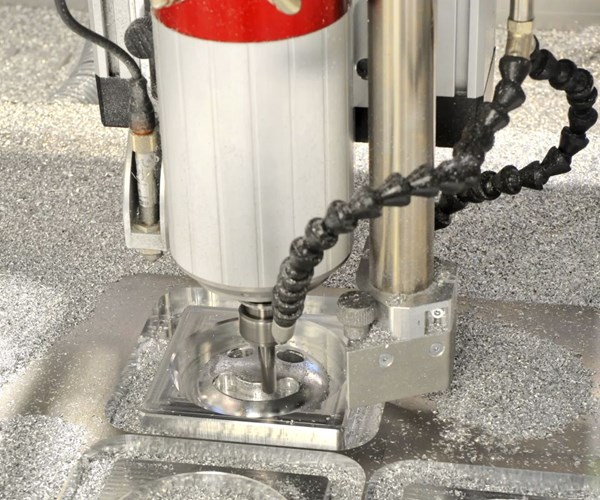Buying a VMC: Considering Toolchanger, Coolant Delivery and Chip Removal
Among characteristics like structure and spindle quality, here are a few factors to consider when buying a vertical machining center.
Share






Chip removal is an important consideration that is often overlooked in the evaluation of a new CNC machine.
Whether it’s for a toolroom, a job shop or a production house, there are a lot of factors to consider when it comes to acquiring a vertical machining center (VMC). Key preliminary considerations include the intended application and workpiece(s) and the needs of a shop’s various departments. And then there’s the research and data-gathering process.
In addition to characteristics like structure and stability and spindle details, potential VMC buyers should keep in mind how the toolchanger, coolant delivery and chip disposal systems contribute to overall machine efficacy.
Selecting the Toolchanger
The toolchanger specified for a new VMC must have an adequate number of tooling pockets and be able to accommodate the size and weight of the cutting tool assemblies. Every VMC has a maximum tool weight and diameter that its toolchanger can handle to prevent a tool from dropping out of the pocket.
In high-production environments, where many tools may be required to machine the parts, tool-change time can have a substantial influence on efficiency. For example, having a machine capable of a 1.4-second chip-to-chip tool-change time, rather than 3.6 seconds, can quickly add up to more productivity and profit.
Coolant Concerns
For certain applications, optional provisions for delivering coolant at high pressure directly through the spindle are recommended. Coolant pressure as high as 1,000 psi is intended to promote chip evacuation from deep bores in which chip breaking is directed at the tool point. Unlike time-consuming peck-drilling cycles, through-the-tool, high-pressure coolant enables the material to be removed in one pass. This approach may reduce drilling time by as much as 30 percent. Additionally, the part remains cooler, surface finishes inside the bores are protected, accuracy of the parts is maintained and cutting tools last longer.
For high-pressure coolant, the capacity of the coolant tank may need to be enlarged. Likewise, an oil skimmer may be an option to consider for extracting waste oil from water-soluble coolant.
Chip Removal
Chip removal is an important consideration that is often overlooked in the evaluation of a new CNC machine. Whether chips are evacuated from the machining zone with water, oil or air jets, they will fall to the bottom of the machine. A smaller volume of chips can be removed by an auger, which is typically standard on most VMCs, but a large volume of chips may require a conveyor. Although it is possible to have the machine operator manually remove chips from the machine, this task is labor-intensive and messy. Using a chip auger or conveyor to remove chips automatically and deposit them in an external bin is recommended. Pay attention to whether the chip conveyor or auger evacuates the chips from the side or rear of the machine, however. The location of the chute determines how much space will be needed on the shop floor, how close the machine can be placed to other machines or walls, and how easily a fork truck can retrieve a loaded chip bin.
Do Your Research
, a free research center and analysis tool, can help a shop find the right VMC for the job. Simply enter the basic attributes and specifications that are required, and the system will provide a side-by-side comparison by machine type, model and builder.
This is part three of a three-part series about buying a VMC.
- Part one: Considering Structure and Stability
- Part two: The Basics of Spindle Speeds and Tapers
Find more insights about acquiring a new machining center by visiting the Techspex Knowledge Center, “.”
This blog post was adapted from an article by Barry Rogers published in the Machine/Shop supplement to ¸ßĹâÂĘÁůşĎ˛Ę magazine.
Related Content
Inverting Turning and Five-Axis Milling at Famar
Automation is only the tip of the iceberg for Famar, which also provides multitasking options for its vertical lathes and horizontal five-axis machine tools.
Read MoreHow to Mitigate Chatter to Boost Machining Rates
There are usually better solutions to chatter than just reducing the feed rate. Through vibration analysis, the chatter problem can be solved, enabling much higher metal removal rates, better quality and longer tool life.
Read MoreLean Approach to Automated Machine Tending Delivers Quicker Paths to Success
Almost any shop can automate at least some of its production, even in low-volume, high-mix applications. The key to getting started is finding the simplest solutions that fit your requirements. It helps to work with an automation partner that understands your needs.
Read More4 Commonly Misapplied CNC Features
Misapplication of these important CNC features will result in wasted time, wasted or duplicated effort and/or wasted material.
Read MoreRead Next
Machine Shop MBA
Making Chips and ¸ßĹâÂĘÁůşĎ˛Ę are teaming up for a new podcast series called Machine Shop MBA—designed to help manufacturers measure their success against the industry’s best. Through the lens of the Top Shops benchmarking program, the series explores the KPIs that set high-performing shops apart, from machine utilization and first-pass yield to employee engagement and revenue per employee.
Read MoreAMRs Are Moving Into Manufacturing: 4 Considerations for Implementation
AMRs can provide a flexible, easy-to-use automation platform so long as manufacturers choose a suitable task and prepare their facilities.
Read More




















